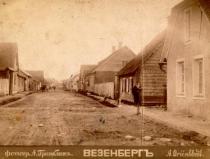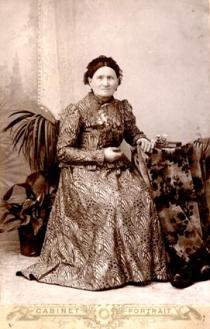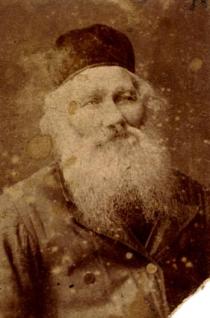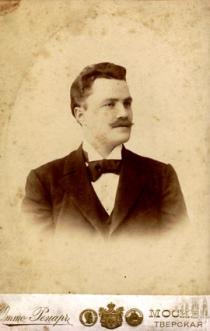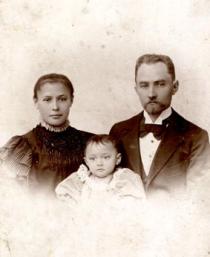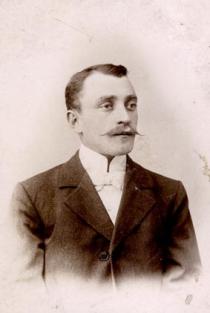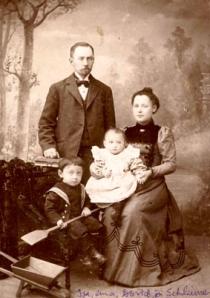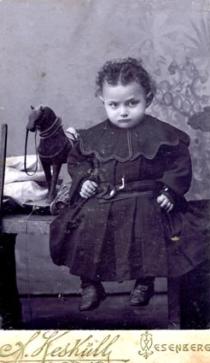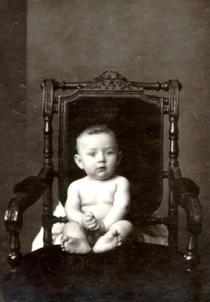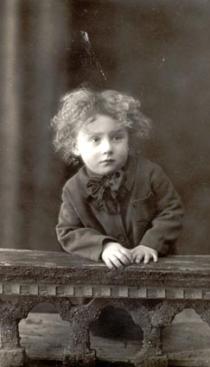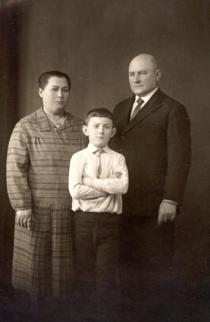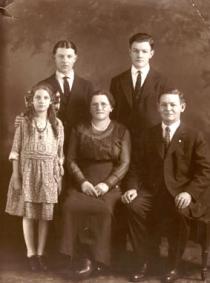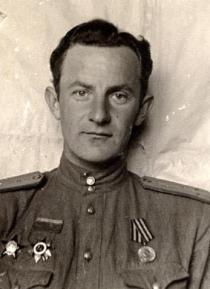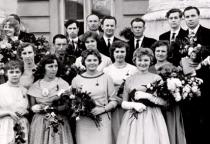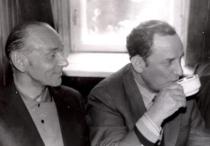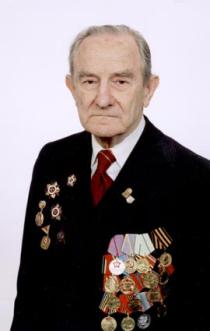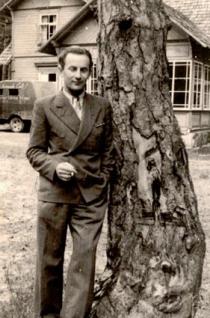
Isaac Serman
Tallinn
Estonia
Interviewer: Ella Levitskaya
Date of Interview: June 2005
I met Isaac Serman in the office of the Jewish community of Estonia 1. Isaac is a rather tall, slim man with a good posture. He is gray-haired, with refined features and a charming smile. It was hard for Isaac to speak Russian as his native tongue is Yiddish and he used to speak Estonian and to study in German, French and Estonian schools. Anyway, he gladly told me about himself and his family and recollected a lot of things. He did not say much about his wife and daughter as he thought that it was their life and he did not think he had the right to talk about them in details. I did not insist as it is his right to determine what he wants to tell and what not.
The Soviet Invasion of the Baltics
My family background
My father’s family lived in a small Estonian town, Rakvere, located 100 kilometers away from Tallinn. Rakvere had a very advantageous geographic position. The roads to Tallinn and Petersburg were through the town. In 1866 two Jews came to Rakvere, which was called Viesenberg at that time. My parental grandfather, Tsvi-Girsh Sorkin, was one of them and the other one was his companion, Aaron-Eadle Friedman. At that time Jews were banned to live in Rakvere as there was a Jewish Pale of Settlement 2 in tsarist Russia, but both of the arrivals were good tinsmiths, having five years of experience. Besides, tinsmiths were in demand in Rakvere and not only in the town. There were large estates in the whereabouts of the town and experienced tinsmiths were needed there, so they were permitted to settle in the town. I also heard that apart from them there were other Jews in Rakvere, Cantonists 3, who served in the tsarist army, but I do not know if that was true.
Actually my grandfather and his friend started the Jewish settlement in Rakvere. In the late 1880s there were 100 Jewish families in Rakvere. It is known that in 1870 the Jews of Rakvere were permitted to open a Jewish town cemetery. The reason for that was the death of two Jews – Cantonists. They were buried in the Jewish cemetery in Rakvere. My grandfather Tsvi-Girsh Sorkin was buried there next. He died rather young, in 1894. Grandmother died in Rakvere in 1903. She was buried next to Grandfather in the Jewish cemetery of Rakvere in accordance with the Jewish rite.
I do not know exactly how my grandmother Tsive-Feiga came to Rakvere. I supposed she got married to Grandfather and went there with him. I do not remember where they lived before their arrival in Rakvere. It was a small town on the border of Russia, Belarus and Poland.
Their first-born, my father, came into the world in 1872 in Rakvere. His Jewish name was Shmuel, and he was called Samuel in accordance with the documents 4. Three more children were born after Father. I do not remember the years of their birth. The second son was Jacob, the third was Biniumin. Father’s younger sister was called Tsipe.
The family lived in their own house. It was a spacious one-storied wooden house. The synagogue was in front of the house. It was a large, two-storied synagogue. Men prayed on the first floor and women – on the second.
When Father was born Grandfather put the surname Sherman, not Sorkin. He did it on purpose, for Father to avoid being drafted into the tsarist army. Thus, Father became Sherman.
Grandfather died rather young. The eldest son had to take care of the family. He did not study much, just finished cheder and two or three years of compulsory school. Father was very inquisitive and witty. He was well-read and self-taught. He knew a lot of things.
Father and his younger brother Biniumin learned tinsmith skills from Grandfather. Both of them worked. Father’s brother Jacob left for Moscow before the revolution 5, when Estonia was part of the Russian empire. He was taught tailoring there. Jacob became one of the best tailors in Moscow. With time, he had his own salon, located at Kuznetsk most, in the center of Moscow. By the way, that atelier is still there. After the Revolution of 1917 Estonia commenced its struggle for independence 6 and as a result the First Estonian Republic 7 was declared, so Jacob turned out to be abroad and could not return to Estonia.
First, Father helped him, sent parcels with food as people in Russia were starving at that time. Then Jacob stopped keeping in touch with his relatives residing in Estonia because for citizens of the USSR it was dangerous to correspond with relatives abroad 8. Of course, after the revolution Jacob’s atelier was sequestrated and nationalized, but he still kept on working there and did not change his work place.
We knew that Jacob was married, had two daughters. I did not know any of them. We managed to find them and they came to their house after the Great Patriotic War 9, but they did not want to see us as it was the time when people were afraid to meet foreigners. We were foreigners for them, though Estonia was already Soviet [see Occupation of the Baltic Republics] 10, but they could not overcome that fear.
Father’s brother Biniumin stayed in Rakvere. He worked as a tinsmith. His wife Leya was a housewife and raised children. Biniumin and Leya had four daughters: Tsilya, Blume, Gerta and Braine.
Father’s younger sister Tsipe left for the USA when she was an adolescent. There she married a Jew named Wulf and gave birth to two sons. First the Wulf family lived in New York, then they moved to Washington and finally they settled down in Detroit.
Unfortunately, I know much less about my mother’s family. She did not like to talk about herself. The family was large and the children were scattered all over the vast territory of the Russian empire. Our relatives lived in Dvinsk [now Daugavpils, Latvia], in Kaunas [today Lithuania], Pskov and other Russian cities.
Mother’s family settled in Vilnius, which was a Polish town at that time. The Jewish population of Vilnius was large; it was even called small Jerusalem. There were about 100 rabbis in Vilnius. Three relatives of my mother, I think uncles, were rabbis in Vilnius. One of them was Itshok. I was named after him. The only thing I know about my maternal grandparents is their last name – Shubich. I do not know for sure how many siblings my mother had, all I know is that the family was large. My mother Ite, or Ida was the youngest. She was born in Vilnius in 1878.
Mother’s family was religious. They observed Jewish traditions, went to the synagogue on Sabbath and on Jewish holidays. Sabbath and all Jewish holidays were marked at home with all traditions being followed. Kashrut was observed as well. My mom’s mother tongue was Yiddish.
There were no Jewish schools for girls at that time, but my mother was educated. She was fluent in Ivrit and Yiddish, of course. She could read and write in both of those languages. She also knew Russian, German, Estonian and Polish. Mother studied on her own and read a lot.
There were few eligible brides in Rakvere and many guys went to the cities with large Jewish communities to look for wives. So, Father left for Vilnius in order to find a spouse. Mother was very gorgeous and when Father saw her he said that he would not leave without her. They got married in 1897. Father was 25 and Mother was 19. Certainly, they had a traditional Jewish wedding as it could not be different at that time. All weddings in Rakvere were according to the Jewish rite.
After getting married, my parents moved to the house of Father’s parents. When my elder brother Dovid was born in 1898 they rented an apartment. It was a rather large maisonette and Grandmother Tsive-Feiga moved in there with us. The second son, Shleime, was born in 1900. It was written Solomon in his documents, but at home my brothers and I were called only by our Jewish names. In 1901 Meishe – Moses in his documents – and his twin were born, but the twin-brother lived for only three weeks and died. The deceased infant was buried in the Jewish cemetery of Rakvere next to Grandfather. In 1903 Ekhonon was born and in 1906 my sister Agness came into the world. I do not know her Jewish name. She was called Agi at home.
Growing up
I was born after a big gap, in 1918. My parents were not young any more and did not think that they would have any more children. I was named Itshok, but Isaac was written in my documents. The birthday of my mother and I are close: she was born on the 5th candle of Chanukkah and I was born the following day, after the 8th candle.
Father had his own workshop, where he manufactured different tin things. Father usually worked by himself in his shop, but he always had an apprentice. When the apprentice had enough skills to work independently he left, and Father took another apprentice. Uncle Biniumin usually worked on his own. When there were large orders from the estates – making fencing, roofing – Father and Uncle worked jointly. They left to the neighboring estate and worked there on the spot.
I remember once they worked on an estate, located 6 kilometers away from Rakvere and stayed there for three months. Every week Mother, I and Biniumin’s wife went there and brought them food. They came home on Friday evening in order to mark Sabbath at home and go to the synagogue the next day. It was sacred to them.
First Father sold his things on the market. Later he could afford to have his own store. Then he hired an assistant, a young guy from Rakvere. His father was killed in action during World War I and his mother died, so Father took the orphaned boy as an apprentice. I do not remember why his leg was amputated. He helped Father both in the workshop and in the store.
Of course, Mother always helped. She supplied for him at the counter, when he had to leave the store. If Father was selling his things on the market, Mother was sitting in the store. She coped with the chores and raising children. She was a wonderful mother. Even now, when I am eating tasty Jewish dishes, I always think that my mother cooked them better. No matter how busy she was, she always found time for us, children. We shared our anxieties and joy with her. She was a good listener and gave us good advice.
Our family was religious. My parents strictly observed all Jewish traditions. My father was the warden of the synagogue [gabbai] in Rakvere. Like any gabbai he was a member of the board of the Jewish community of Estonia. Father was a convinced Zionist 11. Only Yiddish was spoken at home. It is my mother tongue and I often speak Yiddish with my wife.
Only kosher food was cooked at home. Mother had separate dishes for meat and milk. There was a shochet in Rakvere. He butchered cattle in accordance with the kashrut. There was a store where meat was brought from the abattoir with a special Jewish department, where only kosher meat was sold. Mother never laid the table with meat and milk dishes. Even now there are families where milk and meat dishes are served at the same time, but I do not mix those products. I have been used to it since childhood and I do not want to give up that tradition.
All Jewish holidays were marked in the family the way they were supposed to. On Pesach matzah was baked for the whole community. There was a family of bakers – the Sorkins. They were our distant relatives. Before Pesach all Rakvere Jews got together in their place and baked enough matzah for each Jewish family of the town. I also was given work: I made holes in the matzah with the help of some small gadget. I still remember the taste of that matzah. It was not baked the way it is now. Eggs were added and it tasted much better than matzah does nowadays.
There was a special Paschal set of dishes in every Jewish family of Rakvere. It was used only on Pesach. It was stored separately and taken out only for that holiday. On Pesach father held the seder – the first and the second. The whole family took part in that.
For every holiday Mother cooked traditional Jewish dishes as well as the dishes meant for the holiday. On Pesach there was matzah in the house and on Purim – hamantashen. For Purim Father always made rattlers for us. We were supposed to scare off the villain Haman with the help of those rattlers. On Chanukkah Father always gave us whipping tops. Of course, we always fasted on Yom Kippur.
We had a large library at home. It was collected by Father. Though my father did not study that much, he read a lot to fill in the gaps in his education. He taught us very many things. The sons, including me, went to cheder. There was no cheder for the girls in Rakvere. I do not know where my sister got Jewish education, but she knew everything, a Jewish girl, future mother, was supposed to.
There was no state anti-Semitism in the period of the First Estonian Republic, but still there were restrictions for Jews. Jewish people were not admitted to the state service, had no position in the government. Jews were not admitted to military schools for officers. Many guys, who finished compulsory school, entered schools for officers, and none of them was a Jew. Other than that, there were no restrictions, but still Jews in Rakvere preferred to stick together. When I was a child, there were 35 Jewish families in Rakvere. All of them came to each other for all family ceremonies: weddings, bar mitzvah etc. I do not remember non-Jews attending such celebrations, though the attitude to them towards Jews was quite good.
There was a very strong Jewish community in Rakvere. We had a rabbi, chazzan, shochet. There was an Ivrit teacher in cheder, who had finished a yeshivah in Riga. There were several rich Jews in Rakvere. They donated large amounts of money to the community, for the maintenance of the synagogue and cheder. My father regularly made contributions to the community. Apart from that all Jews of Rakvere collected money for Palestine. We had a Jewish club, attended by Zionists. Our father was a Zionist and all of us were his followers. We attended Zionist meetings in the Jewish club.
All children, but the eldest brother, Dovid, went to school. When he was a toddler, he fell down and hit his head. Then he was getting sick and started losing his memory. I remember him very well: I was 20 years younger than him. I walked around in short pants, and Dovid, dressed like an adult man, seemed to me a higher creature. He died in 1922. My second brother, Shleime, died from a cold in 1918. He hardly managed to finish compulsory school. Both of them were buried in the Jewish cemetery in Rakvere.
My brother Meishe finished a Russian lyceum, Ekhonon and my sister Agness studied at a German lyceum. Having finished lyceum Meishe entered Tartu University, the Medical Department. When he was entering the university, the subjects there were taught in Russian, but when he was studying, Estonia became independent and teaching was in Estonian. My brother was specialized in psychiatry. Upon graduation he worked as assistant to a famous Estonian professor of psychiatry. Then Meishe came back to Rakvere and started practicing medicine.
He got married in Rakvere. Meishe had known his wife-to-be since childhood and they cared for each other since then. This girl’s father was a millionaire. He had a large tannery factory, where 60 or 70 people worked. He asked my father to lend him some money. Father signed bills of exchange for him and soon he went bust. Father had to pay money for the bills of exchange so he did not want Meishe to marry that man’s daughter. But they loved each other so much, that Father did not want to be in the way of their happiness.
Father helped Meishe finish university and paid his tuition. When Meishe returned to Rakvere, Father gave him money to equip his office, where he received patients. Meishe and his wife had a traditional Jewish wedding. They lived separately from us, but their happiness did not last long. They lived together until their daughter was born. Meishe’s wife died in parturition. My brother mourned over his dear wife. He took good care of his little daughter.
My brother Ekhonon was a wonderful guy and I loved him a lot. Ekhonon finished Russian lyceum in Rakvere. He strove to help the family the best way he could. He started out rather early, at the age of 16. There was a large fur enterprise with a large warehouse in Rakvere. Ekhonon went to work there. He became knowledgeable about the furs and worked with furs all life long. Ekhonon worked in Rakvere for a while but with the outbreak of unemployment in 1926, he left for Buenos Aires, Argentina, with his friend. Ekhonon became a rather renowned expert in furs.
In two years sister Agness came to join him. A friend of brother Ekhonon, who left with him, married my sister. They would have stayed in Buenos Aires longer, but the climate was too sultry for the Northerners and the three of them moved to Paris, France. My sister was pregnant, when she came to France. Her son was born in 1929. My brother Ekhonon was an expert in furs and fur articles in a large French company. Besides, the three of them acquired a leather manufacturing enterprise in the 1930s and lived large.
I was the only one from our large family, who stayed with the parents. Before going to compulsory school, I went to cheder. When I was to start school, Father decided that I should go to a German lyceum. There were quite a few Germans in Rakvere and most students in the lyceum came from German families. But still, there were Estonians and Jews too. All subjects were taught in German. I did well.
In 1931 I went through my bar mitzvah. My brother and sister, who lived in France, decided to give me a present on the occasion. They invited me to France. They paid for my trip. In 1932 Mother and I went to France for the first time. Father stayed in Rakvere as he did not want to lose his job. We stayed with siblings for a while and came back to Rakvere. When we were in France, Ekhonon was hired by a large company producing fashionable clothes and he went to Canada to purchase 20,000 white foxes in Canada. He was considered to be a great expert.
In 1933 Hitler came to power in Germany 12. We knew a lot about fascism: oppression, sequestration, imprisonment. Estonia disapproved of fascism and refused all German things. In that period of time Father changed the spelling of our surname: Sherman sounded German and he changed it into Serman, as it more resembled Estonian.
In 1933 Father decided that it would be better for us to move to France, to be close to his son and daughter. Father sold his shop and store and we left for Paris. I learned French pretty quickly. I entered French school and studied there for two years. My parents liked life in France and they wanted to settle down there. In 1935 the King of Yugoslavia came to France. The Minister of Foreign Affairs of France met him in Marcel. A terrorist opened fire and both of them died. After that incident all foreigners who had lived in France for less than two years, were exiled from the country. We had to come back to Estonia.
The only thing we had was our house. Neither the shop nor the store were there. We practically had nothing to live on. My brother Meishe had become a famous doctor by that time and made pretty good money. He helped us with money and bought a small store for Father. There were large stores in Rakvere, where the same goods were sold as my father offered.
Under such condition Father could not regain his footing. The firms, which supplied the stores with the goods, were not interested in such petty vendor as my dad. Large stores purchased a lot of goods, but Father did not have money for that. The trade was very passive and there was not enough money to get by. If Meishe had not helped, we would have starved. Upon our return to Rakvere my brother Meishe and his daughter moved in with us.
I was not admitted in the German lyceum. My brother went to the director and asked him to admit me, but he said that the lyceum was now only for German children and they were not permitted to admit Jews. I entered the Estonian lyceum. I spoke good Estonian and studied pretty well. People treated me pretty well in the lyceum. I was a member of the boy scouts organization. I was conferred the title of scout master. I was the leader of a large group. There were only three Jews in it. In general, the Jews of Estonia were closely connected with the Estonian population and Estonians treated them well.
Upon graduation I hunkered for leaving for Palestine. But right after finishing lyceum I was drafted into the compulsory Estonian army. My army service went pretty smoothly. By fellow soldiers as well as commanders treated me pretty well.
In 1939 when German troops were crushed in Poland, the Molotov-Ribbentrop Pact 13 was signed between the USSR and Germany. Shortly after that, Soviet troops entered Estonia 14. They said that Soviet military bases would be established on the territory of Estonia. I remember the day, when the armored troop-carriers regiment, where I was serving, was sent towards the border. We were totally confident that we would have to fight. On our way we were stopped and told to come back to our unit.
On 30th April 1940 I was demobilized and came back home. Things were evolving so that Estonia would be with the Soviets. Of course, there was no way I could go to Palestine. There was no work for me in Rakvere. I could work in Jewish enterprises, but there were no enterprises like that since the tannery factory went bankrupt. The only opportunity I had was to move to Tallinn.
The Soviet Invasion of the Baltics
In June 1940 Soviet troops came to Estonia. The parliament was dissolved and new elections were announced. I took part in them. I was for the Soviets. Of course, at that time I knew hardly anything about the Soviet Union. I thought that it was the country, where everybody was equal, and not oppressed. If I would have known what the Soviet Union really was…
My former classmate, who knew that I was a scout master and worked with children, suggested that I should work with school children and form a pioneer organization 15 in Rakvere. I happily accepted the offer. None of us knew what kind of pioneer organizations were in the USSR and we made that organization as per sample of a scout organization. I was captured by work. I decided to enter the Komsomol 16. My form was sent to the Central Komsomol committee. They refused me on the ground that my father owned a store. Then nationalization commenced and my father’s store was taken. We were lucky that it was a small store bearing scarce income. Owing to that our family escaped deportation 17.
I lived with my parents. I had a rather good salary – 600 rubles. It used to be big money at that time. I gave my salary to Mother and left pocket allowance for myself.
In May 1941 I became a candidate to the party. I craved for studying and I submitted my documents to Tartu University. In September my classes were to start.
During the war
There was a park with a dancing hall in Rakvere. Young people like to get together there and dance. On Saturday, 21st June 1941, I went dancing. The next morning, I wanted to sleep longer in the morning, but there was a knock at our door early in the morning. I was called to work. There I found out that the war was unleashed. In the afternoon I was told to leave for the town of Jōhvi, which was between Rakvere and Narva. There mobilization was underway. I was sent there as a translator. Soviet military units were to conduct mobilization and many Estonians did not speak Russian.
My brother Meishe was assigned the doctor of the train, which took people to evacuation. The train left on 4th July. My parents left with my brother. They stayed in the village Bolshoye Nagayevo, Perm oblast [1200 km east of Moscow], for the entire period of the war. My brother was deputy chief physician of the military hospital, which was located in the village. I sent them my military certificate and it made their lives a little easier.
Only six Jewish families were staying in Rakvere, when I came back there. On 6th August, at 18:00 we left Rakvere and in two hours the Germans were in the town. On that day I called on every remaining family in the morning. These were the richest families in Rakvere. They didn’t want to get evacuated and tried to persuade me that Germans wouldn’t kill anybody. They thought Germans to be the same as Russians who exiled people in Siberia.
I still talked them into evacuation. There was only one family left. I was banging on their door, but nobody was in or they did not want to open the door. On 18th August 1941 all members of that family were killed. Some people say that they were shot by Germans, but one of my good friends in Rakvere told me that it was done by local people. Before the Germans came to Estonia, there were Estonian armed groups in the forests, which took the German side right away. When we were leaving Rakvere, we were shot at by Estonian groups from the NKVD 18 premises, which they captured. We reached Narva via skirmishes. There the Narva regiment was being formed and on 17th August I entered that infantry regiment as a private. When the regiment had been formed, I was sent to Leningrad.
When our regiment was in Narva, I went to the post office and asked whether there was mail from Rakvere. The old lady on duty said that there were unpacked bales with mail and permitted me to look through them. Strange as it may be, but I found a letter from my brother Meishe and my parents. I found out that they left Rakvere without problems. I got their address. Thanks to that lucky chance I corresponded with them during the entire period of the war.
Leningrad was besieged by German troops [see Blockade of Leningrad] 19. The only connection with the city, Kronstadt, a suburb, was via sea. We knew that Estonia was captured by Germans. Then we found out that many Estonian soldiers and officers took the Germans’ side. After that all Estonians were called off from the front as per Stalin’s order. There were only 26 people in the Narva regiment. There were very many wounded and killed. It is painful to recollect how many people I lost!
I was lucky: I was contused and left in the hospital in the regiment medical battalion. After a while I came back in the lines. I was awarded with the Medal «For Leningrad Defense» 20. Our regiment was positioned by the suburb of Leningrad Petergof. The city was besieged. All militaries were evacuated to keep on struggling. Besides, there was nothing to feed them with. When we got together, we were taken to Kronstadt in a submarine and from there we got to Leningrad. The only way to Leningrad was via Lake Ladoga, the so-called Road of Life 21. We were sent in the harbor, called New Ladoga to cross the lake. We stayed there for ten days without food. We did not even have a piece of bread to eat.
Then we crossed Lake Ladoga with the workers of Leningrad plant. It was late fall and the lake was covered with ice. We were incessantly fired at by the Germans during our crossing. Then we, about 100 Estonian guys, took a train to Chelyabinsk [1600 km north-east of Moscow], where the Estonian government was in evacuation 22. I asked for permission to leave the train and see my parents, but I was refused.
We kept on moving and when we reached the town of Babayevo, not far from Tikhvin station, our train was bombed by German planes. It is hard to describe how terrible it looked: our crushed train, distorted rails, cadavers and wounded all over. Those, who survived by miracle, were given another train and we went on. It took us three weeks to get to Chelyabinsk. When we finally arrived there, only four of us, who had families in Chelyabinsk, were permitted to stay. The rest of us went farther, to Omsk [2500 km north-east of Moscow].
It was 35 degrees below zero when we got off the train in Omsk. All of us were lightly dressed. When I left the house in Rakvere, it was summer and I did not even take a jacket, nothing to speak of a coat. We, befuddled by propaganda, gullibly used to think that we would be back home in two or three months. We even appointed meetings with those who would survive in Rakvere at 6 o’clock after the war was over – but we were to wait till four years later… We were not given uniforms by the army. Then we started looking for warm clothes.
The former secretary of Tartu regional party committee met us at the station and said that I was to go to the kolkhoz 23. We went to the station of Kolonia, 130 kilometers from Omsk, There were 36 kolkhozes, where only Estonians lived and worked. These were Estonians, who in the 19th century went to Siberia, the Crimea and Georgia to look for fortune, and founded a colony here. We stopped by a kolkhoz named after Karl Marx. It was a large and rich kolkhoz. People lived comfortably there. There were only Estonians, very hardworking people.
On the second day we went to work. We cleaned cow pens. We worked diligently and people from the kolkhoz gave us valenki [warm Russian felt boots], gloves and hats. We stayed with different families. People treated us very well. I remember I marked my birthday there and the locals brought me two cooked geese, white bread and all kind of food. We celebrated New Year’s of 1942 there as well and on 10th January we were told to go to Omsk for the formation of the Estonian corps 24.
Before departure we were even given wages in the kolkhoz – trudodni 25. I got six sacks of grain. I left them with the family, were I lived. Women baked bread, rolls for me to take and gave me half of the piglet. So, we did not starve in the train on our way to Omsk. We were on the road for a week as we had to let military trains go first. We were sent to the division from Omsk. When I was in compulsory army service, I was in artillery, so I was assigned deputy commander of squad #354 of the rifle regiment. Of course, another reason for that was my being candidate to the party.
Divisions were still formed. They started the formation of the 2nd division and reserve regiment for the replenishment after battles. There were 32,000 people. At that time the Estonian corps had not been formed yet, there was only a division. Thousands of Estonian guys were coming from everywhere. At the beginning of the war they were mobilized in the army and then called off the front as per order of Stalin and sent to the labor army 26.
They worked under severe conditions in the North, starved and died from emaciation and overwork. More than a third of the Estonians who were there, died in the first winter. Those who came to us were exhausted and sick. We had very good doctors, and thanks to their care and good food those guys got well. The Siberian climate was very auspicious for us – dry and clean air, aroma of pine forest. Doctors made sure that we had the infusion from pine sprouts. That is why we did not have scurvy and beriberi. Of course, there were severe frosts, which was hard on us.
I was to conduct military training for the guys and teach them army discipline. Of course, it was very hard to do – as those who came back from the labor army, had a difficulty walking, even slowly. It was way too hard for them to march, go hiking. I understood that and did not force them. Things gradually got better. I started to take the guys from Rakvere.
So, the day came, when we had to get on the train and move towards the West, to the front. Only when we passed the Ural, we were told that we were heading to Stalingrad. We were stopped on our way and told to head towards Moscow. Our division stayed in Egoryevsk and the second division – in Kostroma. Only there, on 25th September 1942, our Estonian corps was formed. We stayed in the vicinity of Moscow for two months, wherefrom we were sent to the front. First, we were on Kalinin front, Toropetsk district. It was the first snow. We made huts and stayed there for a while.
In early December we marched towards Velikiye Luki. On 12th December 1942 our Estonian corps had the first battle. The battles were fierce, with a lot of bloodshed. I and the lieutenant, who was sent to us from the former Estonian corps, were the only ones, who were battle-seasoned in our squad, where I was the commander. The rest did not have any experience in battle. The casualties were big – it was a mêlée. Only 3800 survived out of 10,000 people in our division. Though, there were a lot of wounded who came back to the squad. I also was wounded in those battles and came back in the lines after having been treated.
We lost a lot of good lads there. One of them was Kulman, the husband of my cousin Gerta, the daughter of Uncle Biniumin. He came there in replenishment troops. I met him before the battle and asked him to come to me after the battle. He was killed in action and was dead by evening. My friend from Rakvere, Blekhman, also perished. He was a tall and handsome guy, a good sportsman. There were 50 Jews in our regiment only 12 people survived the battle at Velikiye Luki.
We did not have experience in battle tactics, there was no proper reconnaissance. We had big causalities, but we managed to take the town anyway. It was the first military operation of the Soviet army, when our troops besieged the town and the battles were in the town and on the streets. It was like that in Stalingrad, but the Battle of Stalingrad 27 was after Velikiye Luki. It means, that our battle was the first to come and we had the battles in town before the Stalingrad army.
There were skirmishes and close fighting. We talked to the Germans. They suggested us surrendering and we suggested that they should surrender. I was an interpreter. When I was wounded in the arm, my good fellow, a Jewish guy from Tartu named Leo Grossman, supplied for me. He is still alive. Leo was interpreting; when the town was captured all German commanders came out for negotiations with our corps commander. My wound was not severe. The bone was not touched, and after staying in the medical battalion of the regiment for a short time, I came back in the lines. I was awarded the Red Star Order 28 for the battle in Velikiye Luki.
We were very well armed. In 1942 we had a set of uniforms and good weapons. I should say that in 1941, when we were in the vicinity of Leningrad, we had obsolete bayoneted rifles from the Estonian army. They were used towards the end of war. We were on bayonet attacks in 1944 and in 1945. Though, at that time those rifles were remade for modern bullets. Not all military units had such ammunition. I was in the artillery regiment, and I was certain that we had good and modern cannons. In 1943 five-bullet machine-guns, antitank and anti-cannon guns appeared. I can only speak about our Estonian corps. Maybe it was different in other units. At any rate our artillery was better armed than the Germans’.
I think that Estonians were lucky to have the Estonian corps. There was good order and good relations between people. General-lieutenant Lembit Pārn was the commander of our Estonian corps division. He had served in the army for over 20 years. He had been army headquarters commander by the time when Estonian corps was formed. Then he was division commander, i.e. he was considerably reduced in rank, but still he reckoned it to be a great honor for him. We were among ours in the Estonian corps. We spoke Estonian. We could organize amateur performances and go in for sports. It was luck to serve in the Estonian corps, but only for those who survived the war. Many people died. We will always keep them in our hearts.
Since the period of formation in Siberia, the soldiers of our corps did not starve. In spite of all adversities of military life, we got a daily ration of bread of 800 grams. We received such a ration throughout the entire period of war. Every day we were given soup. Of course it was not like in the restaurant, but it was fresh and warm soldiers’ soup. It was hard after Velikiye Luki. We were positioned in such a place where communication was not advantageous and there were not enough products. For three months we were fed millet, but still we were fed and nobody was hungry. My kin in evacuation was starving, getting only 200 grams per day…
After Velikiye Luki our Estonian corps took part in many large battles: in the vicinity of Nevel, Novo-Sokolniki, Kingisepp. During the battles out of Kingisepp I met my cousin Tsilya’s husband. He was wounded in battle. I took him from the battle field. He was crippled and died shortly after war. In January 1944 we were repositioned to the Leningrad front. Our train was to take off in Oranienbaum, the same place where we were in 1941 [Oranienbaum was the name of the town of Lomonosov before 1948. It is located in Leningrad district with a dock on the southern coast of the Gulf of Finland. Oranienbaum bridgehead was built in September 1941 during defense actions of the Leningrad front].
Of course, all that was different. We were not retreating, but, on the contrary, were victoriously attacking. So, here we came to the Narva River with Leningrad troops, wherefrom we went to Estonian land. Soviet troops were positioned on a small spot by the river. Our artillery was reinforced there. In February 1944 we started crossing the Narva River. There were fierce battles. The ice on the river was red with blood. The Soviet army, having severe casualties, had to retreat. Only in July 1944 we managed to cross the river and get to the opposite bank. The artillery of the Estonian corps took part in those battles.
At that time I was deputy commander of the artillery group of our infantry regiment. 250 people from the Estonian corps were awarded for the Narva battles. There were four Jews among them. I was not awarded for those battles. I was not awarded for any battle on the territory of Estonia, though I was the one who was at the lead, calling upon regiment troops.
During the crossing of the bridge across the Mustajōgi River I was in the first boat. Fact is that the deputy political officer of the regiment, was a good person, but he didn’t like me. When the political officer of the regiment, my good friend, told him that Serman should be awarded, he said that Serman should include himself in the list. Yes, I made the list of the people to be awarded, but how could I have included myself! Thus, I remained without awards for the liberation of Estonia.
Only when that man was transferred to another place, I was awarded. Our commanders included me in the list for awards. The division commander or corps commander made the final decision with regards to awards, but the highest awards were approved in the headquarters of the army. I can say that the soldiers of Estonian corps were condoned when it came to awards. There were cases when people were included in the list for high awards, but a lower-class award was given, but still it was given. I remember that after the battle in the vicinity of Narva I included a leader of our artillery group in the list of people to be awarded the Red Banner Order 29, which was a high award, but a Jewish guy Abram Faiman was included in the list of Red Star Order and got that award.
There was active political struggle in our corps, it was more active than in other units of the army as Estonia became Soviet only in 1940 and we did not know many things. I should say that most of the people who were in the Estonian corps, were true patriots of the USSR. We went to the battles with the words ‘For the motherland, for Stalin!, the same way Russians did.
There were SMERSH 30 representatives in our corps as well as in other units of the Soviet army. Their representatives in the squad were Estonians and we did not have any trouble with them. They were good guys, but their commander, a representative of SMERSH in the regiment, was Russian and, of course, he wanted to do things his way. Though, later our combat commanders did not let him gain control over the regiment. Our senior officers were Estonians. They had wonderful training, having finished English and French military schools.
There were people, who suffered from that Russian SMERSH officer. I personally knew one of them. There was an officer, Estonian, a commander of a squad, who was a wonderful artist and carver. When he had spare time he was making a wooden vase, where episodes of Estonian history were depicted around the vase in the form of coats-of-arms and flags of countries, who occupied Estonia in different times. Among others there were the Soviet coat of arms and flag, then German, as Germans had occupied Estonia by that time. The last part was empty and the artist explained that he deliberately left it empty as it was not known who would be at power in Estonia after the war. Some stooge told on him because of that and he was sentenced to ten years in the Gulag 31. Later I met with that man. He said that he was lucky to have survived the camp.
I became a party member during the war. I did not believe in the Party, but I believed in the Soviet regime. Though, at that time my opinion was ambiguous. I was appalled by things I saw in Russia. I remember I felt so horrible when I saw a Soviet kolkhoz in Leningrad oblast for the first time. They looked so poor and miserable. I was perplexed with the Soviet order, but at that time we did not know things, revealed after the Twentieth Party Congress 32 and later. I knew for sure that I was keeping abreast with the Soviet army on the way to Estonia, to liberate my Estonia from German occupants, and not merely liberate, but to build a new true life. I believed that the Soviet regime could do things like that.
There was no anti-Semitism during the war. It was during the first years of the First Estonian Republic and during the Soviet time. It was an exception in military time. There were about 500 Jews in our corps, but I never came across anti-Semitism towards me. There were a lot of Jewish officers. I finished the war with the rank of major. There were Jewish doctors in our corps. Two of them were from Rakvere, Doctor Zaltsman and Doctor Faiman. My brother Meishe, who was commander of the rear hospital, had the rank of captain of medical service.
I have a Red Star Order for the battle in Velikiye Luki. The medal for the Defense of Leningrad is also dear to me as well as an Order of the Great Patriotic War of the 2nd class 33 for battles in Latvia. After the war I was given an Order of the Great Patriotic War of the 1st class.
After the war
In spring 1945 we were sent to Latvia, Kurland. We were to take the position of Latvian divisions. The Latvian corps was not as lucky as we were. It was totally crushed. There were no more than ten people in their squad, when we took them over. I met some of them after the war. The Latvian corps had dreadful casualties, was practically wiped out.
Battles in Kurland were severe and fierce. Germans were desperately fighting as they understood that the war was drawing to a close. We lost about a third of the corps in those battles. It was dreadful that Estonia had been liberated by then and many of our soldiers had already seen their parents, wives and were to die after that.
On 8th May 1945 our corps entered a new frontier in order to fight the Germans. In the evening, the corps commander ordered us to stop and have a rest. We were not supposed to take any actions without his new order. It was the last order the commander of the corps gave us during wartime. At night it was announced that Germany had capitulated. It was the end of the war.
Unfortunately, I was not in the division at that time. I was wounded in the head a couple of days before that. My wound was serious. I stayed in the tent of the medical battalion for three days and then came back to the unit. When we were to move to a new territory, I was sent to the hospital. My wound was not cleaned very well and I had complications. Thus, I marked Victory Day 34 in a front-line hospital. I was operated there as well. Then there was Stalin’s order not to discharge the wounded from the hospital until their ultimate recovery. I was sent to Riga for treatment. My wound was cleansed every day, the rest of the time was mine. I was allowed to leave the hospital for some period of time. I even went dancing. Then I was discharged from hospital and went to Tallinn.
I was lucky I was in Tallinn that very day, when the Estonian corps was entering the town. It was an unforgettable day! In Tallinn the column of soldiers of the Estonian corps, which was 8 kilometers long, marched along the road, strewn with flowers. The soldiers were welcomed in Riga the same way. I was in the hospital, when our corps was walking across Riga. Then in Tallinn they marched on the road strewn with flowers, covering a distance of 500 kilometer. There were tables laid with food set up along the road. We were given food and drinks. All of us were rejoicing! Now they call us occupants…
I knew that my kin came back from evacuation and settled in Tallinn. The house, where we lived in Rakvere, was destroyed during bombing. My brother Meishe was sent to Tallinn. He was assigned deputy chief of the Healthcare Department of Areman province, the administrative center of which was Tallinn. My parents went with him. They were given a one-room apartment.
When I went to see them and found out that Mother was on the brink of death. She had cancer. She kept to bed for eight and a half months. Mother went through a terrible ordeal: she had beautiful nice teeth and before her death, they fell out. She was grinding her teeth so hard when she had pangs that her teeth triturated. Meishe gave her analgetic injections, but they did not relieve the pain all the time. When I was demobilized, Mother was not alive any longer. She died in 1946. She was buried in the Jewish cemetery in Tallinn. Strange, but the Germans did not demolish that cemetery. It remained untouched.
The war took many lives of our close people. When the war was unleashed, my quarter [quarter is a close family friend, who takes a child to the rite brit (milah) and is present there during the process of the rite] was killed even before the Germans entered Tallinn. He and his wife were very close to our family. They did not have children of their own and I was like a son to them. I came to Tallinn for school holidays twice a year and stayed with them. I remember I went to the dancing parties of the Maccabi club 35. I had friends in Tallinn. They were my age. I was close with my family. The wife of my quarter managed to get evacuated to Russia and died in evacuation.
The son of Father’s brother Biniumin also perished. The husband of my sister Agness joined the resistance troops in the south-east of France. He was captured by Germans. When he was arrested, my sister was pregnant with her second son. My sister’s husband was sent to a concentration camp. That was it. At that time we did not manage to find out more about him, and now we cannot do that either. My brother Ekhonon, who lived in France, was also captured by the Germans. He was sent to Dachau. My brother was among those eight people, who escaped from Dachau 36. Only two of them survived. My brother reached home and his wife sheltered him on the garret of their house by the end of war. Ekhonon and his wife did not have children and they helped my sister raise her sons.
I stayed in the Estonian corps. Officers got assignments via the Bureau of the Central Committee of the Party. I was sent to Tartu. I served in the headquarters of the 7th division. There was a time when the commander came and I was asked to hold the speech. They liked my report and I was told that I would be sent to Moscow to study. I did not have military education. I only finished compulsory school. I was waiting for the assignment for studies, but it was not coming. Then the deputy political officer of the regiment, Gorohover, was a Jew. He talked to me and said that I had to be demobilized as there was no place for Jews in the Soviet army. I understood that I was right and in 1947 I was demobilized.
I was willing to get education. I did not have any certificate from school. When I left Rakvere, I did not take anything with me, but I was incredibly lucky. In 1941 I submitted the documents to Tartu University and there was a copy of my school certificate and a photograph in the archive of the university. It was very important for me as this way I was able to enter Tartu University. I wanted to enter the History Department.
By that time I had found a job in Tartu, in the editing department of the paper ‘Edasi’, ‘Go ahead.’ It was the first paper issued in Estonia. There was no journalism department at the university and the history department was the closest to my work. One of my entrance exams was Russian language. It was hard for me as I did not know it. Russian was not taught in the Estonian school. All of us spoke Estonian in the Estonian corps. I started studying Russian in order to prepare for the exam. When I wrote my first dictation, there were seven or eight mistakes in each line, but still I studied and passed the exams successfully. I worked and studied at the same time. The work was difficult in itself, and I had to combine it with studies and family, but I was young and ambitious.
I got married on 31st December 1948. I met my wife Riva in Tartu. I am not going to say much about my wife and her family: this is her private life and I do not think I have the right to touch it. She was born in Riga in 1926. When she was a little girl, her family moved to Tartu. Riva has a sister, a couple of years old than she. Riva’s parents were very religious and the daughters were taught Jewish traditions and religion. Riva and her sister studied in a Jewish school in Tartu.
During the war, their family was in evacuation in Kirghizia. There Riva finished а compulsory school. After the war her family came back to Tartu. When I met Riva, she worked in the municipal Ispolkom 37. We fell in love with each other and got married soon. We had an ordinary wedding for those times. We registered our marriage in the marriage registration office and had a modest party with close people. There was no opportunity to arrange for a Jewish wedding and there was no place for it. The Tallinn synagogue 38 was burned down in 1944. Besides, I was not willing to be wed under a chuppah. I was an atheist and a party member. It was not acceptable for me.
In 1948 the state of Israel was founded 39. It was a big joy for me. Once, when I spoke with my colleagues I mentioned that our Jewish state had been established. It did not go through that imperceptibly. It did not go that easy. I was in the trade union of the committee of our paper. Shortly after that talk there were elections in the trade union committee of our paper and I was not elected. Then my good comrade told me that the editor of our paper had come to the municipal committee and said I spoke well of Israel. It was the reason why I was not elected. After that incident in the municipal committee of the party I asked our editor if he knew that the representative of the Soviet Union was the first to bring up the issue on the foundation of the state of Israel. Of course, he did not know that.
After the war almost all leading positions in Estonia were occupied by militaries, soldiers and officers of the Estonian corps. All first secretaries of regional committees of the party as well as local authorities were in the Estonian corps. All of us knew and supported that, but it did not mean that our relations were corrupt. We honestly were working for our country, which we had been defending with weapons in our hands. We did everything for its flourishing. It could not have been different.
When in 1948 a new wave of repressions started in the USSR, the campaign against cosmopolitans 40, we did not hear much about that. How could we have known what was happening in Moscow? We learned from the papers about such events as the death of Mikhoels 41, cosmopolitan processes, the liquidation of the Jewish Anti-Fascist Committee 42 and we felt pretty indifferent and aloof as we had never heard about those people before.
I think there was no cosmopolitan campaign in Estonia as there were very few Jews there. The majority of the indigenous Jews of Estonia perished during the war. Of course, we believed things written in the papers. The articles were not written by unknown people, but by such famous people as Ilia Erenburg 43 and other famous Jewish writers and journalists. We had no grounds to question their articles.
Then, during the Doctors’ Plot’ 44, we started unofficial talks about the eviction of Jews. Of course, those talks were not official. My brother Meishe asked me if I was drying rusks. [Editor’s note: there is a phrase in the Russian language that roughly translates as ‘dry rusks,’ meaning to get ready for repressions from the government. The phrase implies that rusks would be handy in prison.]. I did not get his hint and he said that Jews would be exiled soon. I said that I could not believe that it would happen in Estonia. Until now it is not clear whether there was such an order or not. I read a lot of literature on that issue and found no certain answer. They say that the trains were ready to deport the Jewish population, but I do not know if that was true.
Before finishing university I was transferred to Tallinn to work as an editor with the radio. I was transferred to extramural studies. We lived in Tallinn with my father. It was hard for me to study back in that time. The paper was to be released in the morning, but we had to work on the issue all day long. It was easier for me to work with the radio. There were three chief editors and each of us was on duty for a week. When I was on duty, I was through with work at around 1am.
I remember the day of Stalin’s death in 1953. Before that there were regular rounds-up on his state of health. The Estonian telegraph agency in Tallinn received those rounds-up from Moscow and sent it to all papers and radio stations. In the wee hours of the morning we got the message on his death. We did not leave the office until dawn, and in the morning the message came out in the papers. I do not think we were grieving over that event. We took it as mere fact.
After the Twentieth Party Congress, where Nikita Khrushchev 45 held the speech revealing Stalin’s cult, my belief in the Party was considerably shattered. I did not take Khrushchev serious. When he mentioned in his speech, that for 20 years we would outrun the USA in production of food products, well such a statement made me laugh. Then I crossed out those words in the articles which I was to edit and I was twice reprimanded for that by the chief editor of the radio programs. I thought that if he wanted those words to be the in the text he should insert them and sign after that. Such a statement made by Khrushchev sounded like a sneer.
In general I understood what was going on in the country and preferred to keep my thoughts to myself. There was a large group of Jewish writers and scientists in Tartu and Tallinn, who came from the USSR, mostly from Leningrad. They studied in Tartu and then became famous scientists, for example Lotman 46. When I was working for the paper in Tartu, I started publishing articles right away. I could speak my mind in their presence, as for the rest I bewared of sharing my opinion.
In 1951 our daughter was born in Tartu. My wife and I called her Ita after my dear mother. Unfortunately I was too tied up at work and practically had no time to see my daughter. Nevertheless, I managed to take part in her upbringing. When she was a little girl, she made up her mind to become a journalist. Her little desk was by my desk at home. When I was working, my daughter was next to me. She also had a case with materials. I was an avid reader, so we had a rich library at home. Ita also became a book-worm. She made notes on every book she had read.
My daughter went to a school with profound English studies. She is fluent in English, German and Finnish. My wife and I spoke Yiddish at home. Unfortunately our daughter does not know Yiddish, her mother tongue is Estonian. But still Ita was raised Jewish. She knew all Jewish traditions and the history of the Jewish people. Even in Soviet times we marked Jewish holidays at home. Both grandfathers of Ita, maternal and paternal, lived with us and we followed Jewish traditions.
Of course, in Soviet times we could not observe kashrut. There was no shochet then, but we did our best. We did not have pork at home and my wife cooked traditional Jewish dishes. Men got together for a minyan and prayed. It was unofficial, in somebody’s house. We marked Jewish holidays at home. There was no place to buy matzah for Pesach in Soviet times, so we baked it at home, observing all rules. We also marked Soviet holidays –1st May, 7th November 47, and Victory Day. The latter was the biggest holiday for those who survived and came back home. It was the greatest holiday for us.
Ita finished university, works as a journalist, travels all around the world. She is single and lives with us. I can say that my daughter does well; she is a good person and a good journalist.
My father died in 1958. He was buried next to my mother in the Jewish cemetery in Tallinn in accordance with the Jewish rite.
My brother Meishe got married for the second time after the war. His second wife’s husband was killed in action and she raised a daughter, whom Meishe adopted. They had another daughter, born in the 1950s. Meishe was a very famous doctor in Estonia. His working experience was 53 years. He was a chief psychiatrist, the chairman of the Tallinn psychiatry board. His daughter takes that position now. Meishe died in Tallinn in 1981. He was buried next to my parents in the Jewish cemetery in Tallinn. There is a place for me next to them. It is very important for me.
I know that there was state anti-Semitism during the Soviet regime. I practically did not feel it directed toward me. Probably there were cases when my nationality stood in the way of my career, but nobody said it openly. They found other reasons. There was social anti-Semitism. Probably if a Russian calls a Jew a Yid [offensive derogatory term for a Jew], it does not mean, that he thinks badly about that Jew. Estonians have a saying if they speak of mess, they say ‘as messy as in Jewish store.’ One of my best friends said it in my presence and then he finally bethought, ‘Oh God. Isaac, you understand that I slipped.’ I understand that he was not anti-Semitic and said it by accident... I can definitely say that anti-Semitism in Estonia was not as blatant as in the rest of the USSR, especially when Stalin was alive.
By the middle of the 1960s I was offered the position of deputy chairman in the cinematography committee, i.e., deputy minister. At that time that committee was being formed. My comrades, who were subordinated to me in the army, were also offered a job there. That offer showed how they treated Jews in Estonia. Frankly speaking, I was not willing to accept that offer. We had a wonderful team at the radio. I was a journalist, and liked what I was doing.
Finally I was called by the first secretary of the communist party of Estonia, a very pleasant and interesting person. If somebody had told me before 1940 that I, a Jew, would be offered a position like that I would not have believed it. I said that I did not want to leave my job. In reply he said that I had the right to refuse, but I would never be offered anything again. I had to agree. Did I have any other way out? I worked in the cinematography committee for 17 years and retired in 1982.
In 1968 my wife and I went to Paris to visit my siblings. We had not seen each other for ages and our reunion was joyful. We stayed with them for a while. They gave us leather coats, manufactured in their factory and leather suites for Meishe’s daughters. When Father was alive, Ekhonon and Agness sent parcels for them. Ekhonon died in Paris in 1976, Agness – in 2004.
In the 1970s Jews started immigrating to Israel. Many of my friends from Tallinn and Tartu left. We tried to do what we could for them, celebrated their immigration. We were happy to know that their new life was a success and that they did well. The very idea to immigrate was not bat, but in my circumstances it was impossible. At any rate, I thought like that then. So, I stayed, but even now I would like to visit that splendid country.
I do not consider myself to be religious. I have always been an atheist. Many people think Judaism to be a religion, but in my opinion it is ethics. As for me, it means that I identify myself as a Jew and take pride in it, knowing Jewish history, Jewish life, my mother tongue and literature. I have always marked Jewish holidays at home. It means that I am a Jew. How can I refuse the history of my people? I think that Jewish religion is 90 percent of Jewish history, and I know the history of the Jewish people.
When I started studying in Soviet times, there were no books in Russian or Estonian. So, first I read them in English and French. Now I have a lot of books in Russian and Yiddish. I cannot believe that someone in heaven controls our lives. In that case, I would have to give up science. I tell my friends, Estonians, that all of them are Jewish as their God is a Jew. I do not say Jesus Christ, I say Jeshua ben Eyser. I cannot believe in miracles he made. I think that everyone has a right to believe or not to believe in God and no one should make anyone change his mind.
When Mikhail Gorbachev 48 declared a new course of the Party, I took it skeptically. It seemed to me that nothing would happen. In the end, perestroika 49 lead to the breakup of the USSR [in 1991]. I think that event was natural and it should happen. I live in the small state of Estonia. My peoples live in the small state of Israel. How could I feel calm when Estonia, which used to be independent and happy, was no longer a state in the Soviet Union, but became just a part of the Soviet Union? It was written in our passports that we – the citizens of the Estonian Soviet Republic became true citizens of Estonia only after independence was gained in 1991 50.
The Jewish community of Estonia was founded before perestroika. When Estonia became independent it became the center, uniting all Jews of our country. The community means a lot for all of us. It has become a part of our life. The community was given the building of the former Jewish lyceum 51. I often go there. There is the Council of War Veterans in our community. We get together two or three times per month. There is a good library in community. I take books there to read. I am a passionate reader.
I take part in all holidays, celebrated at the community – Holocaust Day, Day of Israel, Day of the Perished etc. We always celebrate Victory Day. This year, when the 60th anniversary of the victory was celebrated, we had a feast. If the USSR had not won that horrible war, there would have been no Jews left in Europe. In spite of hard life in evacuation and starvation, Jews survived and escaped concentration camps. I am grateful to the Soviet Union for that. Actors, children made performances for us, veterans. There was a great table laid for us. Those, who were in the lines, were given flowers and presents. It was very ceremonious and touching.
Of course, I take part in Jewish holidays. On Pesach I like to hear children ask the traditional four questions, I used to ask my father. I still remember them. Other holidays are celebrated in our community in an interesting way as well. At home we have celebrations as well. It has always been like that. We have monthly birthday celebrations of those, who were born in that month. It is a real pleasure that someone remembers you and takes care.
The community takes a lot of actions on collecting data on Holocaust victims in Estonia. I think in the 1960s there were two trials of those who were involved in the extermination of Jews during the war. Actually, those issues were more raised after Estonia gained independence. There was even an acting commission of the government of Estonia. In accordance with the data of that commission, headed by a Finnish Jew, journalist Max Jacobson, 10,000 Jews perished on the territory of Estonia. There were 20,000 in accordance with the data of our community. The matter is not in the number, the problem was that they were murdered for merely being Jews. Estonia was the first to tell Hitler that its territory was free of the Jewish population. All of us should do our best for it not to happen ever again.
Our community built monuments in five places of mass execution of Jews. Annually I hold a speech at school on Victory Day. If not for the German army, where Estonians served, six millions of European Jews would have stayed alive. If not for the Soviet Army, where Estonians served too, there would be no Jews left in Europe at all. We should remember that.
Glossary:
1 Jewish community of Estonia
On 30th March 1988 in a meeting of Jews of Estonia, consisting of 100 people, convened by David Slomka, a resolution was made to establish the Community of Jewish Culture of Estonia (KJCE) and in May 1988 the community was registered in the Tallinn municipal Ispolkom. KJCE was the first independent Jewish cultural organization in the USSR to be officially registered by the Soviet authorities. In 1989 the first Ivrit courses started, although the study of Ivrit was equal to Zionist propaganda and considered to be anti-Soviet activity. Contacts with Jewish organizations of other countries were established. KJCE was part of the Peoples' Front of Estonia, struggling for an independent state. In December 1989 the first issue of the KJCE paper Kashachar (Dawn) was published in Estonian and Russian language. In 1991 the first radio program about Jewish culture and activities of KJCE, 'Sholem Aleichem,' was broadcast in Estonia. In 1991 the Jewish religious community and KJCE had a joined meeting, where it was decided to found the Jewish Community of Estonia.2 Jewish Pale of Settlement
Certain provinces in the Russian Empire were designated for permanent Jewish residence and the Jewish population was only allowed to live in these areas. The Pale was first established by a decree by Catherine II in 1791. The regulation was in force until the Russian Revolution of 1917, although the limits of the Pale were modified several times. The Pale stretched from the Baltic Sea to the Black Sea, and 94% of the total Jewish population of Russia, almost 5 million people, lived there. The overwhelming majority of the Jews lived in the towns and shtetls of the Pale. Certain privileged groups of Jews, such as certain merchants, university graduates and craftsmen working in certain branches, were granted to live outside the borders of the Pale of Settlement permanently.3 Cantonist
The cantonists were Jewish children who were conscripted to military institutions in tsarist Russia with the intention that the conditions in which they were placed would force them to adopt Christianity. Enlistment for the cantonist institutions was most rigorously enforced in the first half of the 19th century. It was abolished in 1856 under Alexander II. Compulsory military service for Jews was introduced in 1827. Jews between the age of 12 and 25 could be drafted and those under 18 were placed in the cantonist units. The Jewish communal authorities were obliged to furnish a certain quota of army recruits. The high quota that was demanded, the severe service conditions, and the knowledge that the conscript would not observe Jewish religious laws and would be cut off from his family, made those liable for conscription try to evade it.. Thus, the communal leaders filled the quota from children of the poorest homes.4 Common name
Russified or Russian first names used by Jews in everyday life and adopted in official documents. The Russification of first names was one of the manifestations of the assimilation of Russian Jews at the turn of the 19th and 20th century. In some cases only the spelling and pronunciation of Jewish names was russified (e.g. Isaac instead of Yitskhak; Boris instead of Borukh), while in other cases traditional Jewish names were replaced by similarly sounding Russian names (e.g. Eugenia instead of Ghita; Yury instead of Yuda). When state anti-Semitism intensified in the USSR at the end of the 1940s, most Jewish parents stopped giving their children traditional Jewish names to avoid discrimination.5 Russian Revolution of 1917
Revolution in which the tsarist regime was overthrown in the Russian Empire and, under Lenin, was replaced by the Bolshevik rule. The two phases of the Revolution were: February Revolution, which came about due to food and fuel shortages during World War I, and during which the tsar abdicated and a provisional government took over. The second phase took place in the form of a coup led by Lenin in October/November (October Revolution) and saw the seizure of power by the Bolsheviks.6 Estonian War of Liberation (1918-1920)
The Estonian Republic fought on its own territory against Soviet Russia whose troops were advancing from the east. On Latvian territory the Estonian People's Army fought against the Baltic Landswer's army formed of German volunteers. The War of Liberation ended by the signing of the Tartu Peace Treaty on 2nd February 1920, when Soviet Russia recognized Estonia as an independent state.7 First Estonian Republic
Until 1917 Estonia was part of the Russian Empire. Due to the revolutionary events in Russia, the political situation in Estonia was extremely unstable in 1917. Various political parties sprang up; the Bolshevik party was particularly strong. National forces became active, too. In February 1918, they succeeded in forming the provisional government of the First Estonian Republic, proclaiming Estonia an independent state on 24th February 1918.8 Keep in touch with relatives abroad
The authorities could arrest an individual corresponding with his/her relatives abroad and charge him/her with espionage, send them to concentration camp or even sentence them to death.9 Great Patriotic War
On 22nd June 1941 at 5 o'clock in the morning Nazi Germany attacked the Soviet Union without declaring war. This was the beginning of the so-called Great Patriotic War. The German blitzkrieg, known as Operation Barbarossa, nearly succeeded in breaking the Soviet Union in the months that followed. Caught unprepared, the Soviet forces lost whole armies and vast quantities of equipment to the German onslaught in the first weeks of the war. By November 1941 the German army had seized the Ukrainian Republic, besieged Leningrad, the Soviet Union's second largest city, and threatened Moscow itself. The war ended for the Soviet Union on 9th May 1945.10 Occupation of the Baltic Republics (Estonia, Latvia and Lithuania)
Although the Molotov-Ribbentrop Pact regarded only Latvia and Estonia as parts of the Soviet sphere of influence in Eastern Europe, according to a supplementary protocol (signed in 28th September 1939) most of Lithuania was also transferred under the Soviets. The three states were forced to sign the 'Pact of Defense and Mutual Assistance' with the USSR allowing it to station troops in their territories. In June 1940 Moscow issued an ultimatum demanding the change of governments and the occupation of the Baltic Republics. The three states were incorporated into the Soviet Union as the Estonian, Latvian and Lithuanian Soviet Socialist Republics.11 Revisionist Zionism
The movement founded in 1925 and led by Vladimir Jabotinsky advocated the revision of the principles of Political Zionism developed by Theodor Herzl, the father of Zionism. The main goals of the Revisionists was to put pressure on Great Britain for a Jewish statehood on both banks of the Jordan River, a Jewish majority in Palestine, the reestablishment of the Jewish regiments, and military training for the youth. The Revisionist Zionists formed the core of what became the Herut (Freedom) Party after the Israeli independence. This party subsequently became the central component of the Likud Party, the largest right-wing Israeli party since the 1970s.12 Hitler's rise to power
In the German parliamentary elections in January 1933, the National Socialist German Workers' Party (NSDAP) won one-third of the votes. On 30th January 1933 the German president swore in Adolf Hitler, the party's leader, as chancellor. On 27th February 1933 the building of the Reichstag (the parliament) in Berlin was burned down. The government laid the blame with the Bulgarian communists, and a show trial was staged. This served as the pretext for ushering in a state of emergency and holding a re-election. It was won by the NSDAP, which gained 44% of the votes, and following the cancellation of the communists' votes it commanded over half of the mandates. The new Reichstag passed an extraordinary resolution granting the government special legislative powers and waiving the constitution for 4 years. This enabled the implementation of a series of moves that laid the foundations of the totalitarian state: all parties other than the NSDAP were dissolved, key state offices were filled by party luminaries, and the political police and the apparatus of terror swiftly developed.13 Molotov-Ribbentrop Pact
Non-aggression pact between Germany and the Soviet Union, which became known under the name of Molotov-Ribbentrop Pact. Engaged in a border war with Japan in the Far East and fearing the German advance in the west, the Soviet government began secret negotiations for a non-aggression pact with Germany in 1939. In August 1939 it suddenly announced the conclusion of a Soviet-German agreement of friendship and non-aggression. The Pact contained a secret clause providing for the partition of Poland and for Soviet and German spheres of influence in Eastern Europe.14 Estonia in 1939-1940
On 24th September 1939, Moscow demanded that Estonia make available military bases for the Red Army units. On 16th June, Moscow issued an ultimatum insisting on the change of government and the right of occupation of Estonia. On 17th June, Estonia accepted the provisions and ceased to exist de facto, becoming Estonian Soviet Republic within the USSR.15 All-Union pioneer organization
A communist organization for teenagers between 10 and 15 years old (cf: boy-/ girlscouts in the US). The organization aimed at educating the young generation in accordance with the communist ideals, preparing pioneers to become members of the Komsomol and later the Communist Party. In the Soviet Union, all teenagers were pioneers.16 Komsomol
Communist youth political organization created in 1918. The task of the Komsomol was to spread the ideas of communism and involve the worker and peasant youth in building the Soviet Union. The Komsomol also aimed at giving a communist upbringing by involving the worker youth in the political struggle, supplemented by theoretical education. The Komsomol was more popular than the Communist Party because with its aim of education people could accept uninitiated young proletarians, whereas party members had to have at least a minimal political qualification.17 Soviet Deportation of Estonian Civilians
June 14, 1941 - the first of mass deportations organized by the Soviet regime in Estonia. There were about 400 Jews among a total of 10,000 people who were deported or removed to reformatory camps.18 NKVD
(Russ.: Narodnyi Komissariat Vnutrennikh Del), People's Committee of Internal Affairs, the supreme security authority in the USSR - the secret police. Founded by Lenin in 1917, it nevertheless played an insignificant role until 1934, when it took over the GPU (the State Political Administration), the political police. The NKVD had its own police and military formations, and also possessed the powers to pass sentence on political matters, and as such in practice had total control over society. Under Stalin's rule the NKVD was the key instrument used to terrorize the civilian population. The NKVD ran a network of labor camps for millions of prisoners, the Gulag. The heads of the NKVD were as follows: Genrikh Yagoda (to 1936), Nikolai Yezhov (to 1938) and Lavrenti Beria. During the war against Germany the political police, the KGB, was spun off from the NKVD. After the war it also operated on USSR-occupied territories, including in Poland, where it assisted the nascent communist authorities in suppressing opposition. In 1946 the NKVD was renamed the Ministry of the Interior.19 Blockade of Leningrad
On September 8, 1941 the Germans fully encircled Leningrad and its siege began. It lasted until January 27, 1944. The blockade meant incredible hardships and privations for the population of the town. Hundreds of thousands died from hunger, cold and diseases during the almost 900 days of the blockade.20 Medal "For Liberation of Leningrad"
Was established by Decree of the Presidium of the USSR Supreme Soviet on 22nd December 1942. Over one million and five hundred people were conferred with that medal.21 Road of Life
It was a passage across Lake Ladoga in winter during the Blockade of Leningrad. It was due to the Road of Life that Leningrad survived in the terrible winter of 1941-42.22 Estonian Government in Evacuation
Both, the Government of the Estonian Soviet Socialist Republic and the Central Committee of the Estonian Communist Party were created in 1940 and were evacuated to Moscow as the war started. Their task was to provide for Estonian residents who had been evacuated or drafted into the labor army. They succeeded in restoring life and work conditions of many evacuees. Former leaders of the Estonian Soviet Socialist Republic took active part in the formation of the Estonian Rifle Corps assisting the transfer of former Estonian citizens from the labor army into the Corps. At the beginning of 1944, top authority institutions of the Estonian Soviet Socialist Republic were moved to Leningrad, and the permanent Estonian representation office remained in Moscow. In September 1944, Estonia was re-established as part of the USSR and the Estonian government moved to Tallinn.23 Collective farm (in Russian kolkhoz)
In the Soviet Union the policy of gradual and voluntary collectivization of agriculture was adopted in 1927 to encourage food production while freeing labor and capital for industrial development. In 1929, with only 4% of farms in kolkhozes, Stalin ordered the confiscation of peasants' land, tools, and animals; the kolkhoz replaced the family farm.24 Estonian Rifle Corps
Military unit established in late 1941 as a part of the Soviet Army. The Corps was made up of two rifle divisions. Those signed up for the Estonian Corps by military enlistment offices were ethnic Estonians regardless of their residence within the Soviet Union as well as men of call-up age residing in Estonia before the Soviet occupation (1940). The Corps took part in the bloody battle of Velikiye Luki (December 1942 - January 1943), where it suffered great losses and was sent to the back areas for re-formation and training. In the summer of 1944, the Corps took part in the liberation of Estonia and in March 1945 in the actions on Latvian territory. In 1946, the Corps was disbanded.25 Trudodni: A measure of work used in Soviet collective farms until 1966. Working one day it was possible to earn from 0.5 up to 4 trudodni. In fall when the harvest was gathered the collective farm administration calculated the cost of 1 trudoden in money or food equivalent (based upon the profit).
26 Labor army
It was made up of men of call-up age not trusted to carry firearms by the Soviet authorities. Such people were those living on the territories annexed by the USSR in 1940 (Eastern Poland, the Baltic States, parts of Karelia, Bessarabia and northern Bukovina) as well as ethnic Germans living in the Soviet Union proper. The labor army was employed for carrying out tough work, in the woods or in mines. During the first winter of the war, 30 percent of those drafted into the labor army died of starvation and hard work. The number of people in the labor army decreased sharply when the larger part of its contingent was transferred to the national Estonian, Latvian, and Lithuanian Corps, created at the beginning of 1942. The remaining labor detachments were maintained up until the end of the war.27 Stalingrad Battle (17 July 1942- 2 February1943): 17th July 1942 - 2nd February 1943. The South-Western and Don Fronts stopped the advance of German armies in the vicinity of Stalingrad. On 19th and 20th November 1942 the Soviet troops undertook an offensive and encircled 22 German divisions (330,000 people) and eliminated them. On 31st January 1943 the remains of the 6th German army headed by General Field Marshal Paulus surrendered (91,000 people). The victory in the Stalingrad battle was of huge political, strategic and international significance.
